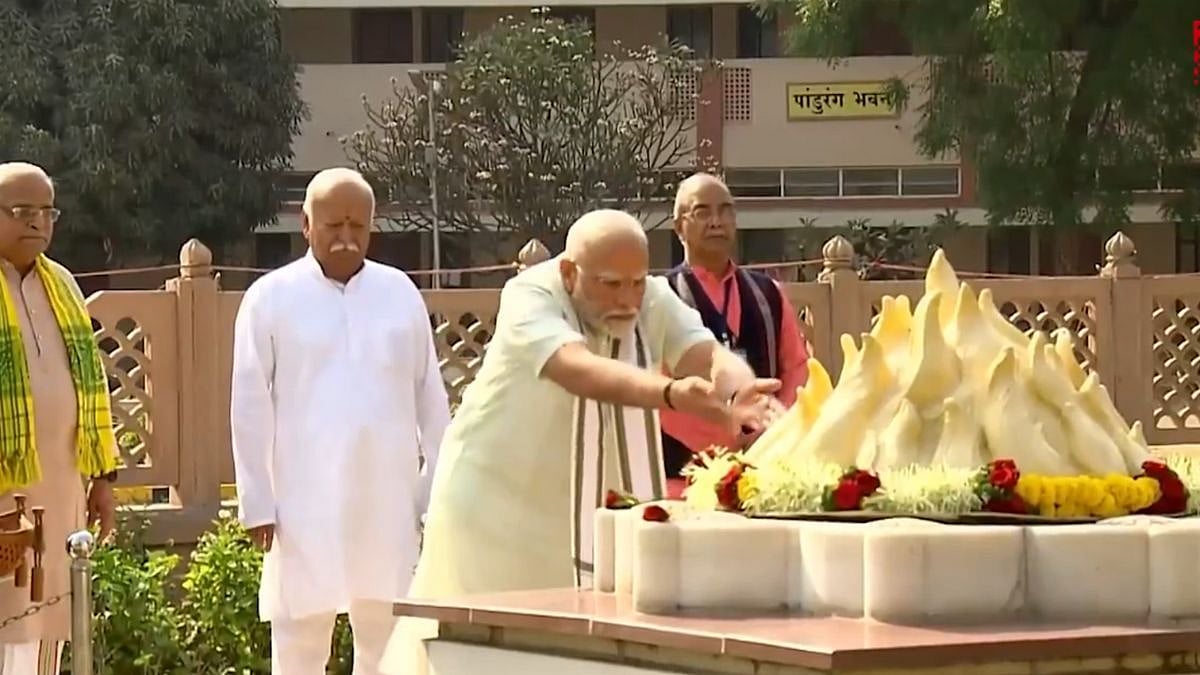PM Modi’s Visit To RSS Headquarters In Nagpur Reaffirms Govt’s Commitment To Strong & Culturally Rooted Bharat | PTI
Mumbai: Prime Minister Narendra Modi’s visit to Nagpur was no ordinary stopover. It was a deeply symbolic journey, underscoring the ideological bedrock of the Rashtriya Swayamsevak Sangh (RSS) and reaffirming his government’s commitment to the vision of a strong, culturally rooted, and developed Bharat.
About PM Modi’s Visit
Modi began his visit at the Dr Hedgewar Smruti Mandir in Reshimbagh, where he paid tribute at the memorials of Keshav Baliram Hedgewar, the founder of the RSS, and M.S. Golwalkar, its second sarsanghchalak. These sites are more than just places of remembrance—they stand as shrines to an ideology that has shaped the course of Indian nationalism for nearly a century.
Writing in the venue’s message book, Modi reflected on the enduring influence of these figures. “The memorial of the two strong pillars of RSS is an inspiration to lakhs of swayamsevaks who have dedicated themselves to the service of the nation,” he wrote in Hindi. “I am overwhelmed to visit the Smruti Mandir, which cherishes the memories of Param Pujaniya Dr Hedgewar and Pujya Guruji.”
The presence of RSS chief Mohan Bhagwat, Maharashtra Chief Minister Devendra Fadnavis, and Union Minister Nitin Gadkari underscored the political and ideological significance of Modi’s visit. The event was not merely ceremonial; it was a reaffirmation of the RSS’s guiding role in shaping contemporary Indian politics.
Modi later took to social media, posting on X: “Visiting Smruti Mandir in Nagpur is a very special experience. Making today’s visit even more special is the fact that it has happened on Varsha Pratipada, which is also the Jayanti of Param Pujya Doctor Sahab. Countless people like me derive inspiration and strength from the thoughts of Param Pujya Doctor Sahab and Pujya Guruji. It was an honour to pay homage to these two greats, who envisioned a strong, prosperous, and culturally proud Bharat.”
PM Modi’s Visit To Deekshabhoomi
From Reshimbagh, Modi proceeded to Deekshabhoomi, the sacred site where Dr B.R. Ambedkar embraced Buddhism in 1956 along with thousands of his followers, in a powerful rejection of caste discrimination. The visit was laden with significance, particularly at a time when social justice remains a focal point of national discourse. Inside the stupa, Modi paid homage to Ambedkar’s ‘asthi’ (mortal remains) and penned his reflections in the visitor’s diary.
“I am overwhelmed that I got an opportunity to visit Deekshabhoomi, one of the five ‘Panchteerth’ of Dr Babasaheb Ambedkar, in Nagpur. One can feel Babasaheb’s principles of social harmony, equality and justice in this holy atmosphere here,” he wrote.
He emphasized that Deekshabhoomi is not just a place of remembrance but a source of strength, urging the nation to uphold Ambedkar’s ideals. “Deekshabhoomi energises people to move ahead with a system of equal rights and justice for the poor, less privileged and the needy,” he noted. Modi further stated that the true tribute to Ambedkar would be building a “developed and inclusive Bharat.”
His words sought to bridge the ideological gap between the RSS’s vision of nationalism and Ambedkar’s blueprint for social justice—two forces that have often been seen in tension but which the ruling dispensation has sought to reconcile. Beyond the ideological tributes, Modi’s visit had a strategic dimension.
At the Solar Defence and Aerospace Limited’s ammunition facility in Nagpur, he inaugurated an airstrip for Unarmed Aerial Vehicles (UAVs) and a facility for testing loitering munitions, highlighting India’s growing self-reliance in defence production. Capping off the day, Modi held a grand roadshow in Nagpur, where throngs of supporters lined the streets to catch a glimpse of him. The overwhelming turnout underscored his enduring mass appeal in Maharashtra—a state poised to play a critical role in the upcoming electoral battles.
